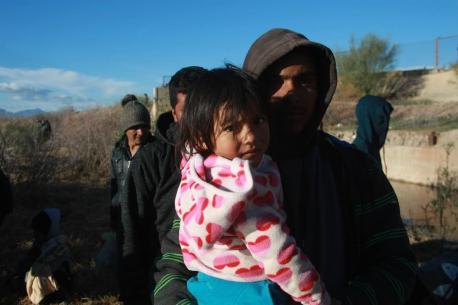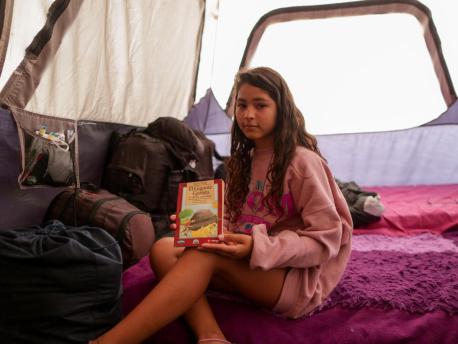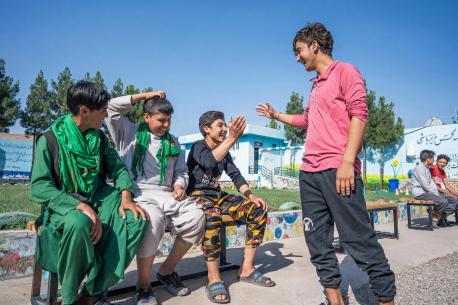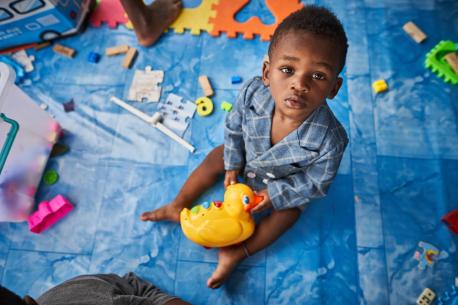
A Girl's Death Spotlights the Dangers Facing Migrant Children
A toddler dies on the border as reports of migrant children held in unsafe U.S. facilities spark demands for action to keep children safe.
UNICEF and partners are working tirelessly all over the world to save and protect children.
The photo of Óscar Alberto Martínez Ramírez and his daughter, Valeria, drowned at the border between Mexico and the U.S., is a shattering reminder of the perils migrant families face while fleeing poverty and violence. It also evokes another heartbreaking image, the 2015 shot of the Syrian 3-year-old refugee Alan Kurdi, whose body washed up on a beach in Turkey after he drowned when the rubber boat he and his family boarded to cross to the Greek island Kos capsized.
Just as Alan’s death sparked vigorous debate over immigration policies in Europe, the photo of the bodies of Ramírez and his daughter, Valeria, demands solutions to the humanitarian crisis taking place at our southern borders and the suffering inflicted on children.
A searing image sparks renewed demands for a solution to the humanitarian crisis on our borders — and an end to the suffering of children
The photo’s release also coincides with national outrage over reports that emerged this week of migrant children now held in government facilities at the U.S. southern border in dangerous and unhygienic conditions.
UNICEF Executive Director Henrietta Fore voiced her deep concern and dismay:
"Children should not be in unsafe environments that can cause toxic stress and irreparable harm to their health and development." — UNICEF Executive Director Henrietta Fore
“Recent reports coming from some of these facilities are grim. Children should not be in unsafe environments that can cause toxic stress and irreparable harm to their health and development. This is a dire situation requiring urgent action and funding to provide children and families with essential services and support,” said Fore, who was just back from a trip to Tijuana, Mexico, where she met children and families from northern Central America at a migrant shelter.
“It’s hard to fathom this happening in a country with such a rich history as a champion for children in need around the world, particularly for those uprooted from their homes and communities by crisis. By any measure, these ARE children in need – I have met them.”
UNICEF protects migrant children — and their rights — at home and wherever their journeys take them
UNICEF is using its decades of humanitarian expertise to promote the protection of migrant children and their rights in their home countries or wherever their journeys take them.
In the U.S., UNICEF USA is working with such partners as the U.S. Conference of Catholic Bishops and the San Diego Rapid Response Network — headed by Jewish Family Service of San Diego — to help migrant children and families by supporting and expanding existing protection measures, including alternatives to detention, advocacy and the strengthening of the sponsor system.

UNICEF Executive Director Henrietta Fore speaks with Nadia, whose name has been changed to protect her identity, and her 1-year old child. Nadia is from Guerrero, Mexico. She fled extortion at home, which made her scared for her daughter and herself. She hopes to go to the U.S. to look for better opportunities and to feel safe. © UNICEF/UN0321649/Carrillo
To help alleviate the root causes of the crisis and support migrant children along the journey, UNICEF is also partnering with governments and civil society organizations in Central America and Mexico to protect children from violence, crime and other threats and to support their access to education and health programs.
None of the migrant children who Fore met on her trip to Tijuana wanted to leave their home countries. But, she says, “All felt they had no choice because of the threat of gang violence or oppressive poverty.”
Children who have fled violence or extreme deprivation at home or suffered harm along the migration route can ill afford to experience further trauma.
UNICEF supports migrant children wherever they may be, but, says Fore, countries of origin, transit and destination must also act to ensure the rights, protection, wellbeing and dignity of migrant and refugee children.
“No one country can do it alone,” she says. “Addressing the root causes of forced migration and the needs of uprooted children require serious commitment, resolve and resources.”
Top photo: Many children like this little girl were among a group of 150 migrants who waited — without food — for three days at the border between Juarez and El Paso, Texas, last December in hopes of entering the U.S. The families said crushing poverty drove them from their homes in Guatemala, Honduras and El Salvador. Photo by David Peinado/NurPhoto via Getty Images.
HOW TO HELP
There are many ways to make a difference
War, famine, poverty, natural disasters — threats to the world's children keep coming. But UNICEF won't stop working to keep children healthy and safe.
UNICEF works in over 190 countries and territories — more places than any other children's organization. UNICEF has the world's largest humanitarian warehouse and, when disaster strikes, can get supplies almost anywhere within 72 hours. Constantly innovating, always advocating for a better world for children, UNICEF works to ensure that every child can grow up healthy, educated, protected and respected.
Would you like to help give all children the opportunity to reach their full potential? There are many ways to get involved.





